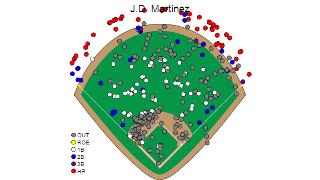|
In the second half of the 2017 season, Giancarlo Stanton terrorized opposing pitchers with 33 home runs in 73 games while slugging .702, a stretch that catapulted him to MVP honors. He was not the best hitter in the league in that span. J.D. Martinez hit 31 home runs in 66 games, slugging .751, in a stretch that might catapult him to the largest free-agent contract this offseason -- $200 million if you believe his agent, Scott Boras, or $160 million or so if you take a more likely appraisal. Either way, it’s a massive sum of money for the player the Houston Astros released in spring training of 2014 to make room for L.J. Hoes and Robbie Grossman. “I’m not really down about it,” Martinez said at the time. “It is what it is. Obviously, Houston is a team that brought me up and where I want to be. Everything happens for a reason.” Martinez was in the midst of retooling his swing that spring, but he hadn’t played much. Two days later, he signed with the Detroit Tigers, though they didn’t call him up until April 21, and he played part-time though mid-May, going homerless in his first 39 at-bats. Then everything clicked. You watch his old swing, and it was all upper body. The new swing uses his legs a lot more conventionally. He talked about how the swing allows his bat to stay in the zone longer and hit the ball harder. Now he’s the hitter Boras is selling as J.D. Kong. Over the past four seasons, he hit .300/.362/.574. Not including 2017 rookies Aaron Judge and Cody Bellinger, only Mike Trout has a higher slugging percentage. Only Trout, Joey Votto, Paul Goldschmidt and Bryce Harper have a higher wOBA. Martinez is coming off a season in which he hit 45 home runs in just 119 games, so he is clearly one of the game’s elite hitters. Nobody doubts the bat, and as he’ll be entering his age-30 season in 2018, a six-year deal takes him through age 35. Even accounting for some regression in the latter years of such a contract, he should remain a productive hitter. It’s his defense in the outfield that raises concerns about his long-term value. Martinez’s defense the past two seasons has rated poorly, with minus-22 defensive runs saved in 2016 and minus-5 in 2017. Dan Szymborski’s ZiPS projection pegs Martinez’s value at five years and $100.8 million, or just over $20 million per season. That value, however, increases to $120 million if he DHs. Add a sixth season, and you’re up to $140 million, which means a $160 million contract doesn’t sound like a huge overpay. Keep in mind that Martinez’s defense might have been somewhat affected in 2016 by the fractured elbow he suffered when he crashed into a wall in June. He also missed the first six weeks of 2017 with a sprained foot. His defense metrics were better in 2015, his last completely healthy season, when he was credited with plus-4 defensive runs saved -- a figure bolstered, however, by 15 outfield assists. More likely, Martinez is comparable to Nelson Cruz, a slugger with below-average range. Cruz played regularly in the outfield through age 32, split time between DH and right field the next two seasons, spent most of his time at DH in his age-35 season and became a full-time DH at 36. From 30 to 35, Cruz was worth 18.6 WAR, even with subpar defensive metrics. That would seem to suggest that Martinez is a better fit for an American League club, knowing the team would have the DH option in the back pocket, but I don’t think it precludes a National League team from going after him. Here are some possible fits: Boston Red Sox The Red Sox were last in the AL with 168 home runs -- 18 fewer than any other team and 73 fewer than the Yankees. Boston first basemen and DHs combined to hit just .242/.321/.424. They’re obviously on the hunt for power, and they could sign Martinez to DH, sliding Hanley Ramirez back to first base. Martinez isn’t a perfect fit, as a lot of his power is to right-center, the difficult home run area at Fenway. Here’s his 2017 hit chart:  The question for the Red Sox is whether they’d prefer Martinez or Eric Hosmer. Odds are they will sign one but not both. Martinez is a couple years older but is the much superior hitter and probably less of a risk than the inconsistent Hosmer. Arizona Diamondbacks Considering the way Martinez hit with Arizona -- .302/.366/.741 with 29 home runs in 62 games -- the Diamondbacks will certainly want to bring him back, and Martinez certainly loved their high-octane hitting environment. The Arizona lineup isn’t really that deep, as only Goldschmidt, Martinez, Jake Lamb and Chris Iannetta had above-average adjusted OPS figures (and Lamb can’t hit lefties). The hitch: Is there room in the payroll? The Diamondbacks had an Opening Day payroll in 2017 of $93 million; the current roster projects to about $121 million, according to Cot’s Contracts, and that’s without Martinez. Keep in mind that Goldschmidt is eligible for free agency after 2019. I wouldn’t rule out Martinez's returning to Arizona -- you could backload the contract to make the first two seasons less costly -- but it seems unlikely that the Diamondbacks would be able to afford both Martinez now and Goldschmidt in two years. San Francisco Giants You could trade for Stanton and the potential $295 million left on his contract -- or just sign Martinez. Sure, a healthy Stanton who hits like he did in 2017 is the better player thanks to his solid defense, but Martinez at $160 million might be the better gamble and won’t cost you any players. Of course, like Fenway, AT&T Park with that big triangle in right-center will steal some home runs, and you’ll have to play Martinez in left field. One way or another, the Giants need a power-hitting outfielder, and they’ve indicated that they’re looking to contend in 2018. Toronto Blue Jays Here’s the kind of amazing thing about American League DHs in 2017: They hit a combined .242/.316/.418 -- worse than the overall league mark of .256/.324/.429. That means a lot of AL teams could use an upgrade at DH. In the Blue Jays' case, they need several offensive upgrades after finishing last in the AL in runs scored. Jose Bautista is gone, and they need a replacement for him in the outfield. The Jays have Josh Donaldson for one more year before he hits free agency. If they’re going to keep him, they better go all-in and sign a big bat. Baltimore Orioles Having been burned by the Chris Davis contract, the Orioles might be hesitant to make another similar signing. Orioles outfielders ranked 23rd in the majors in wOBA in 2017. There’s a hole in right field, and though pairing Martinez with left fielder Trey Mancini and center fielder Adam Jones would be a defensive nightmare, the Orioles’ lust for power is well-known. They also could make the money work. Jones is a free agent after 2018 (that’s $17.3 million off the books), and they’re unlikely to re-sign Manny Machado, so Martinez could serve as a long-term replacement for Machado’s bat. Colorado Rockies This is a dream scenario. Like the Diamondbacks’ offense, Colorado’s is overrated because of its home park. The Rockies actually need another thumper. As it happens, Carlos Gonzalez is a free agent and coming off an awful season, so Martinez would be a big upgrade. Gonzalez was worth 10 runs below average at the plate in 534 plate appearances in 2017; Martinez was worth plus-40 in 489 PAs. Did we mention that Martinez slugged .741 in the second-best hitter’s park in the majors? Los Angeles Dodgers Hey, it’s a rule that you have to include the Dodgers as a possibility for any player who will sign a $100 million-plus contract. They don’t need a left fielder for 2018, as they have Joc Pederson and Andrew Toles, plus Bellinger can play out there. But imagine this lineup: CF Chris Taylor
SS Corey Seager
3B Justin Turner
1B Cody Bellinger
LF J.D. Martinez
RF Yasiel Puig
C Austin Barnes or Yasmani Grandal
2B Logan Forsythe or Barnes Yummy.
|

